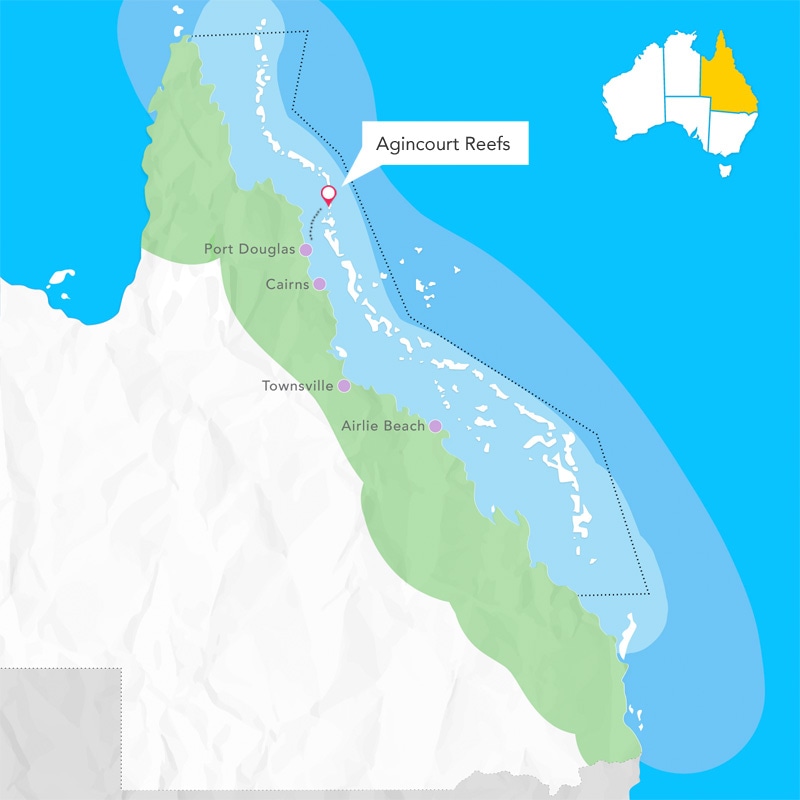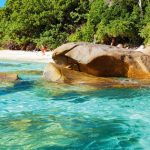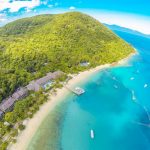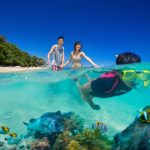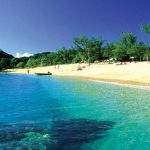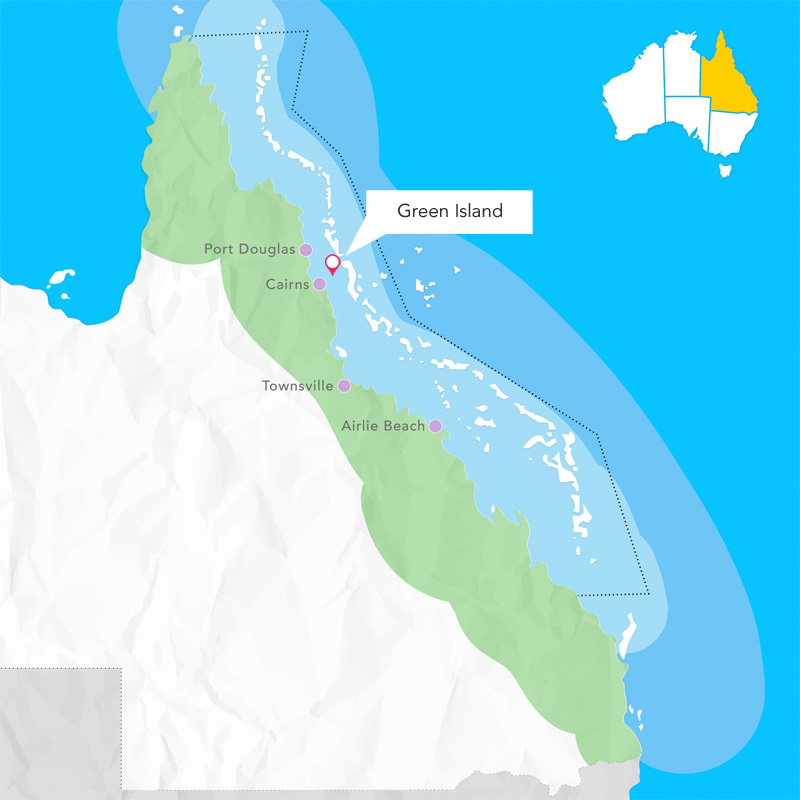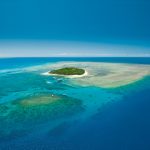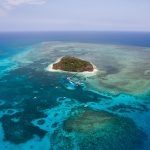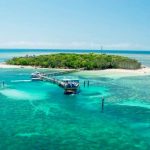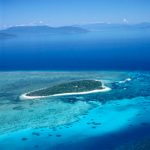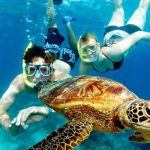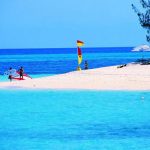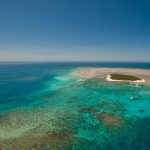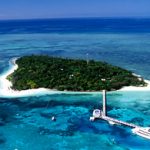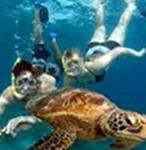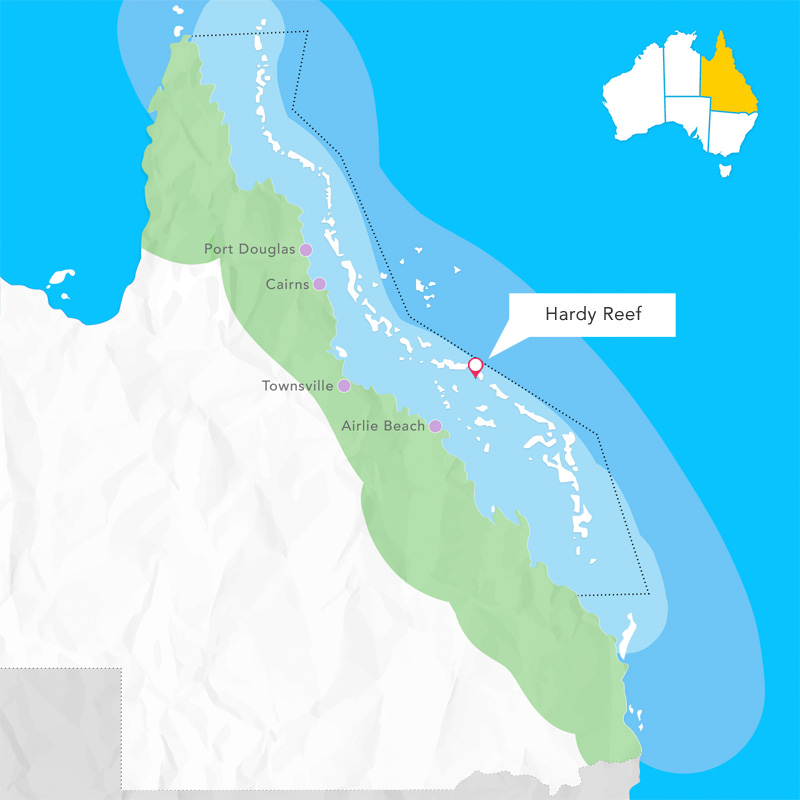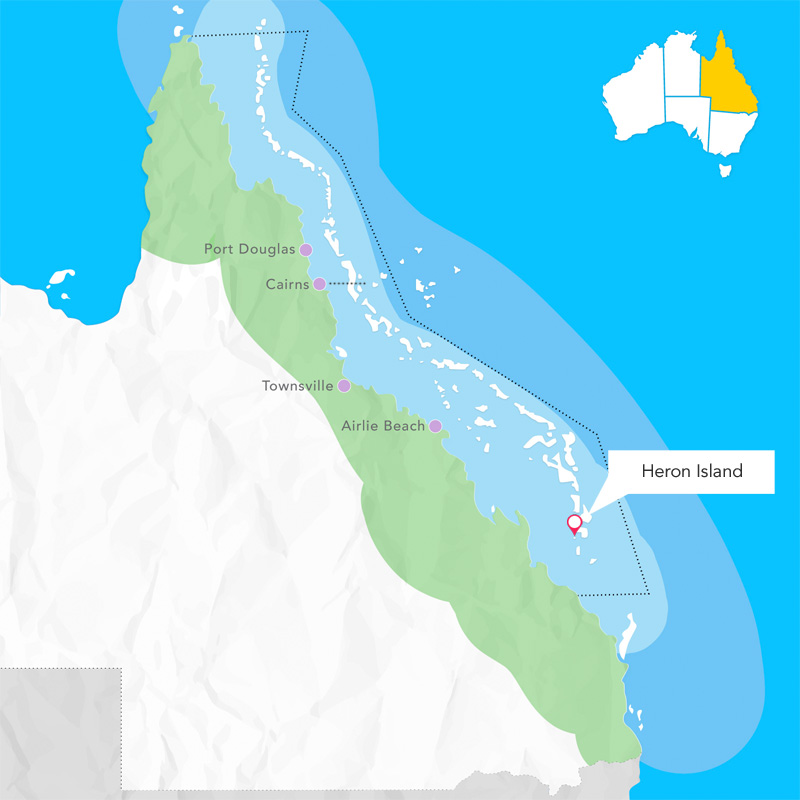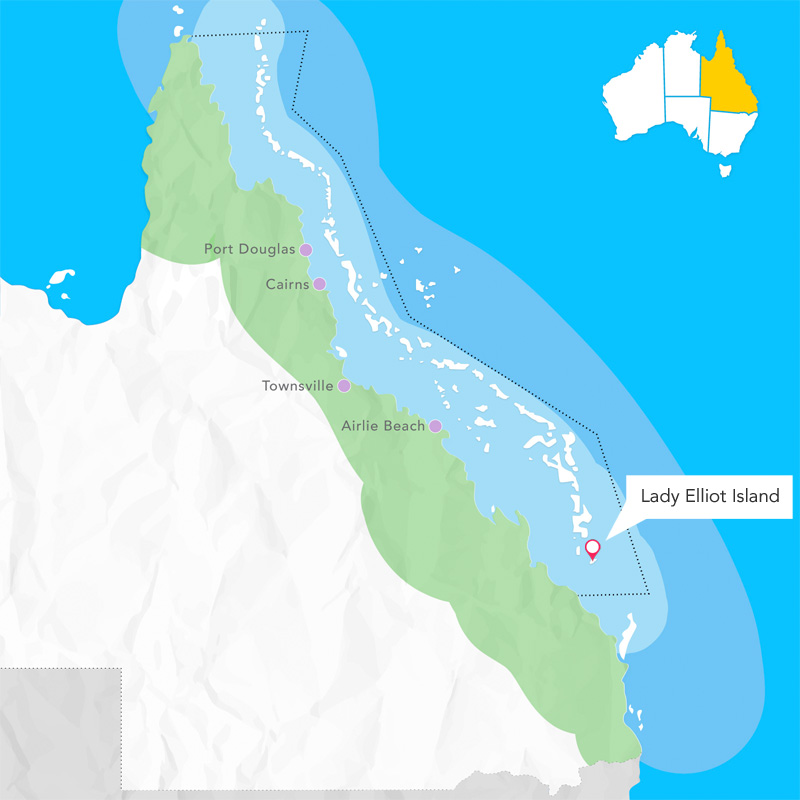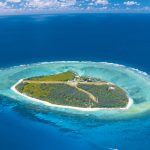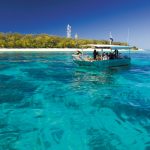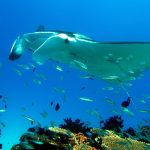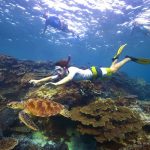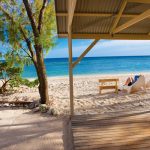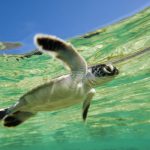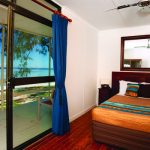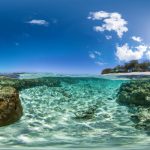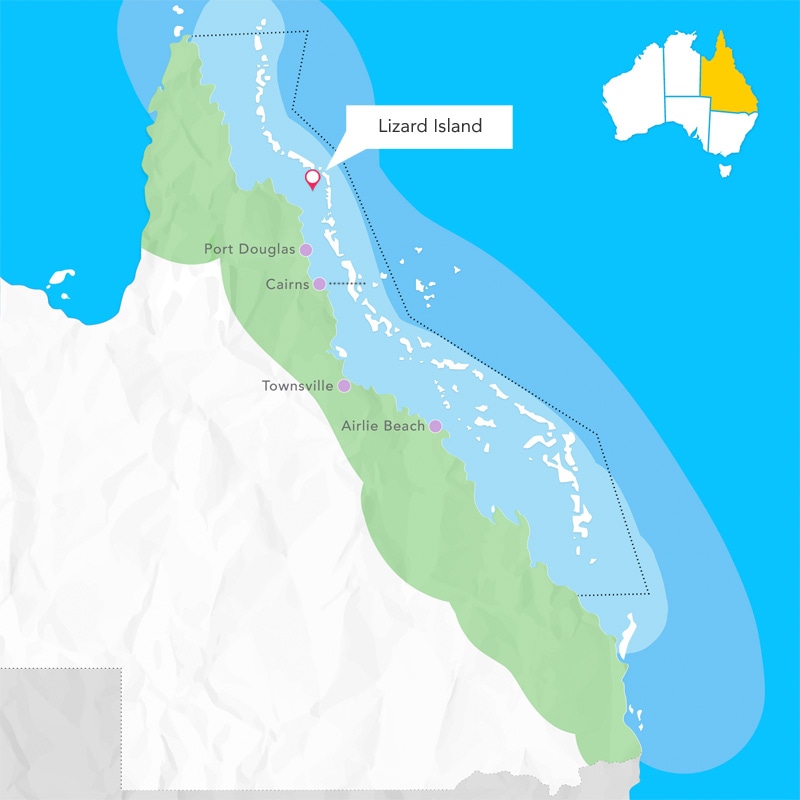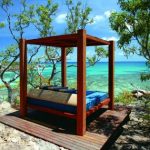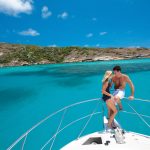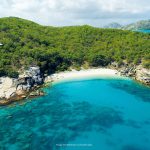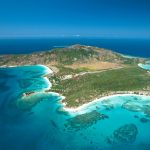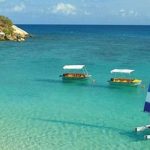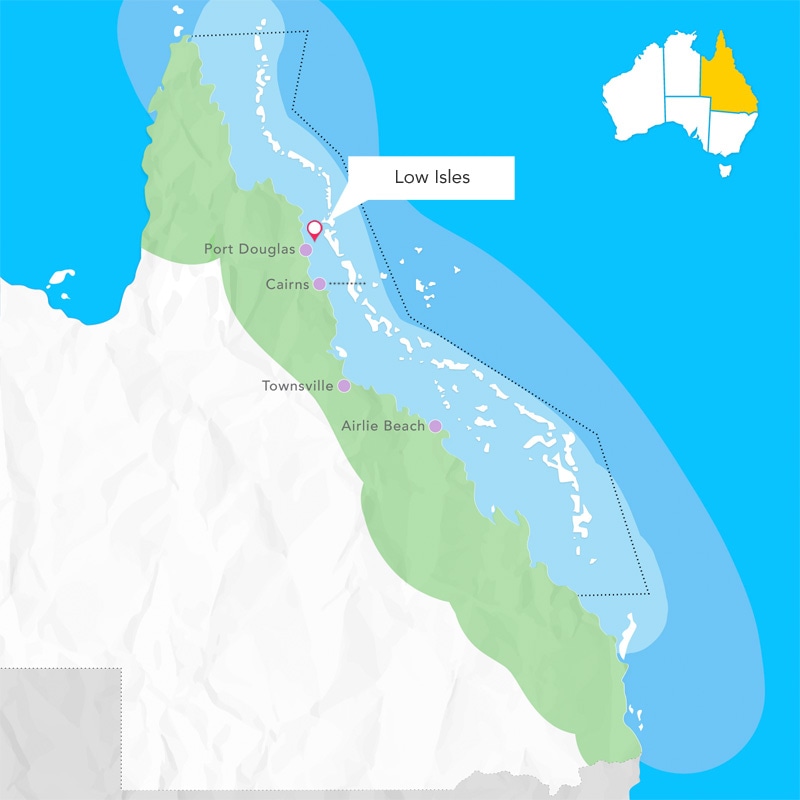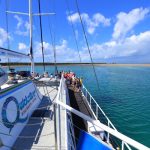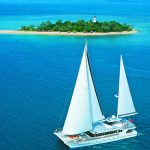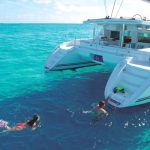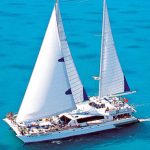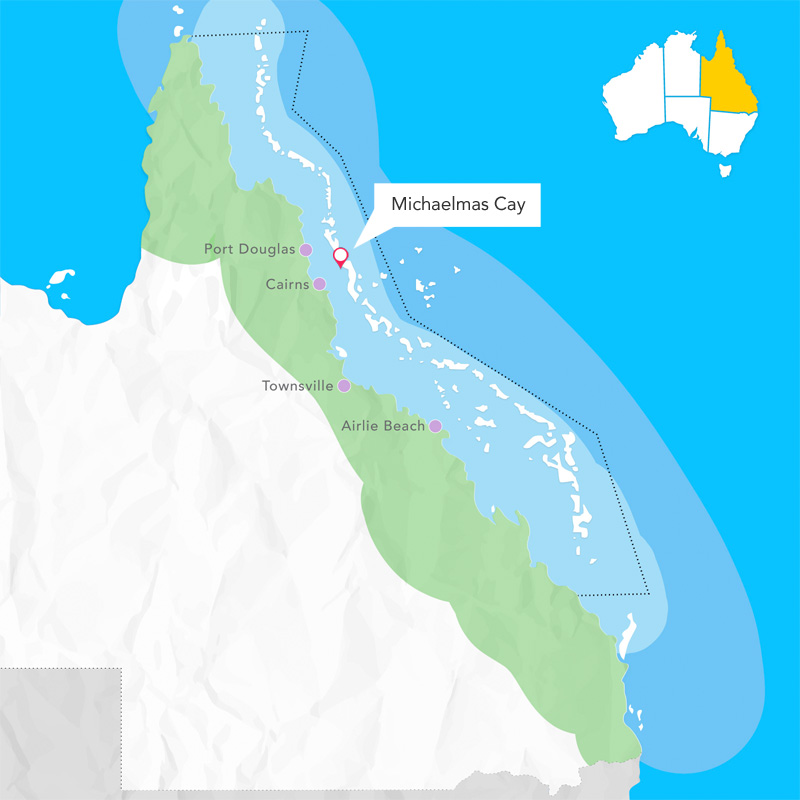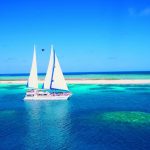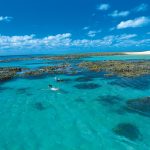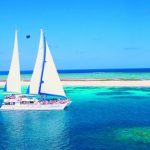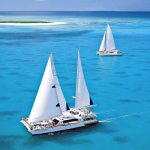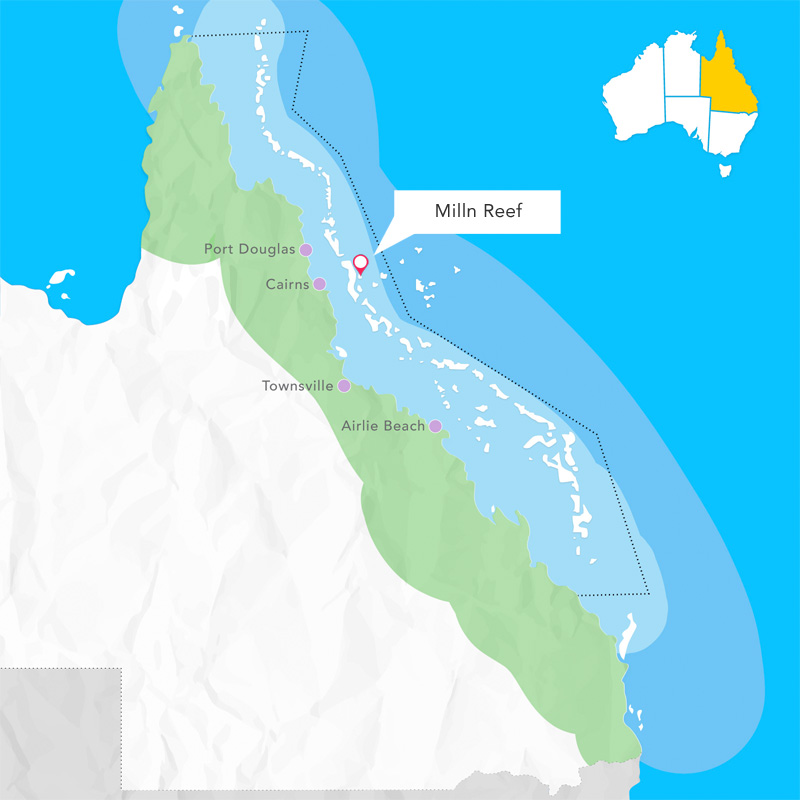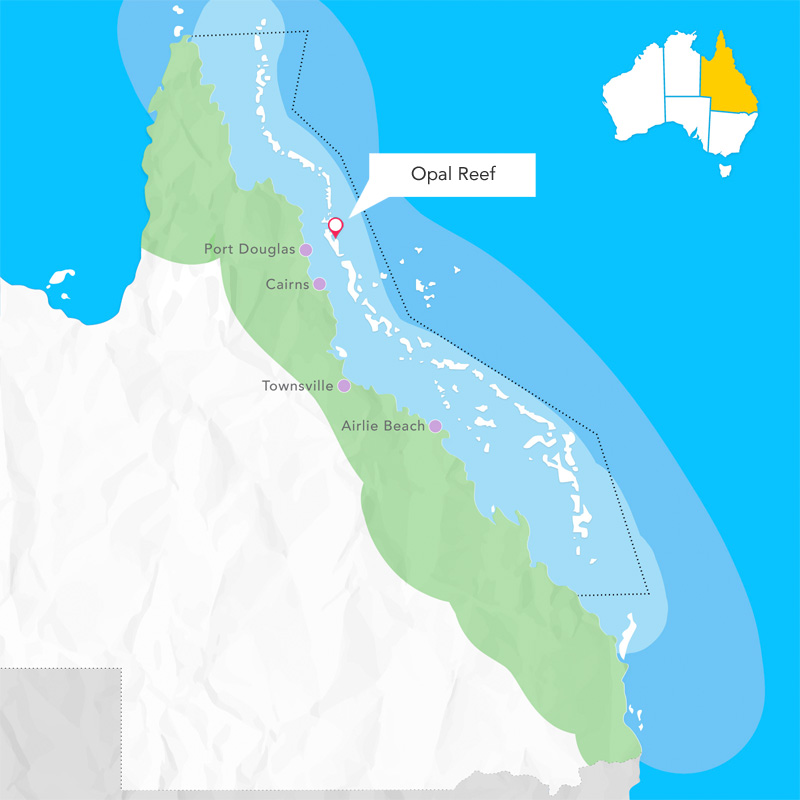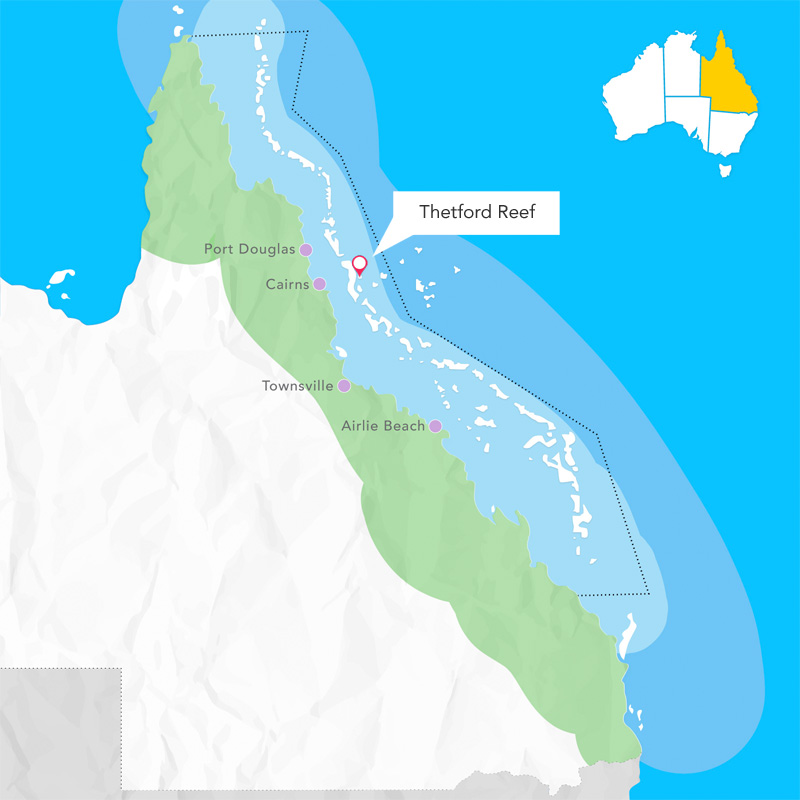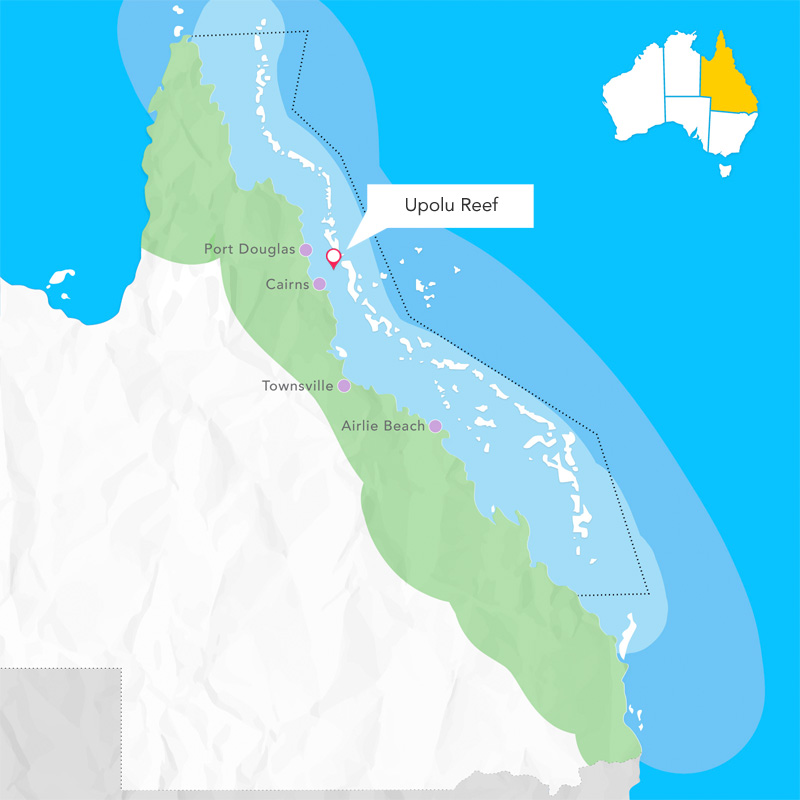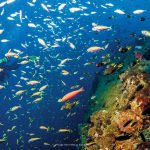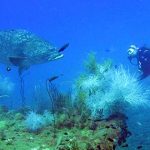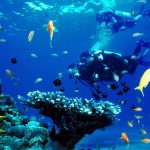Agincourt Reef
- What it offers: Great balance of spectacular Outer Reef with optional convenience of pontoon/activity platform
- Who goes there: Quicksilver/Poseidon, Silversonic, Calypso Snorkel & Dive
- Who it’s best for: Those with mixed needs, e.g: one experienced diver and one non-swimmer; families; those looking for the “best of both worlds” of Outer Reef + convenience of facilities
- Pros: Beautiful Outer Reef coral & marine life; convenient facilities; large range of varied dive sites; highly supervised/safe environment (at pontoon)
- Cons: Popularity means can be “crowded” for Outer Reef (at pontoon); longer travel times than close locations
- How to get there: Cruises depart from Port Douglas
Agincourt reef has long been one of the most popular diving locations in the entire Great Barrier Reef. Situated remotely off the coast of Port Douglas, the Agincourt reef is a collection of small “ribbon reefs”. The Agincourt offers numerous potential dive sites with a blend of channels and gardens for marine explorers to navigate. Luckily, this reef is visited by multiple tour operators showcasing the Outer Reef’s beauty.
This convenience comes courtesy of the large pontoon owned by Quicksilver Cruises which is based here; this large “activity platform” serves as a veritable floating town that can accommodate hundreds of visitors while offering all the benefits of modern facilities such as showers, food, and change rooms.
As a result, Agincourt is one of the most balanced choices in terms of the more frequently-visited reefs; beginners and non-swimmers can stick to the areas immediately around the pontoon, or take part in the likes of semi-submersible rides and an underwater viewing platform to view the marine life while staying dry.
More advanced divers, meanwhile, can head to a number of dive sites at the ends and edges of Agincourt for a mixture of wreck, bommie, and coral garden dives.
The flexibility and facilities on the pontoon makes Agincourt a great choice for first-time visitors to the Great Barrier Reef who aren’t looking to compromise with a shorter trip to the sites closer to the mainland. The inherent trade off, however, comes with increased travel time to and from Agincourt Reef (roughly 90 minutes each way), as well as sharing the reef with plenty of other travellers due to its popularity.
In addition, while the Outer Reef is spectacular regardless, the area immediately off the back of the pontoon is more of a showcase of lovely coral than raw fish numbers – you’ll have to visit a different site on Agincourt to see them at their most plentiful.
The peace of mind offered by the supervised and controlled conditions (there’s even a dedicated roped-off area monitored by a lifeguard just off the back of the pontoon) may be worth the compromise for skittish swimmers.
Several other companies also visit Agincourt Reef including Silversonic, Calypso and Poseidon (a Quicksilver affiliate) and have different anchor points while visiting multiple dive sites. They also tend to carry a lower number of visitors. If you’re a more advanced snorkeler or diver, then these alternative itineraries may provide a more welcome mixture of both reef variety, fish species and coral formations than the pontoon itself.
Visibility at Agincourt is one of its strongest selling points due to its close proximity to the continental shelf but the area surrounding the outer reef pontoon can be busy at times in peak holiday periods.
Agincourt Reef’s remote location is one of its strongest selling points due to the reef’s proximity to the continental shelf; its location on the outer edge of the reef near the Coral Sea trench means the reef is surrounded by deeper water and sheerer drops with wonderful walls of coral.
Agincourt is made up of a series of several isolated bommies rather than a single continual strip of reef, and has a superior reef quality compared to the majority of inner island-based locations at each. There are around 21 individual dive sites here in total, with popular spots including the fish-abundant Castle Rock coral walls; Nursery Bommie with its array of pelagic fish such as barracudas, rays, sharks and eels; Harry’s Bommie which provides the chance to see both sharks and Manta rays; and the Three Sisters on the reef’s inner edge.
In all, Agincourt Reef is the best possible compromise between sampling the beauty of the outer portions of the Great Barrier Reef with options for additional “comfort” factors that some of the less-frequented sections can’t match. As a result, if you’ve got a couple or groups with different desires – or you want convenience on – then the Agincourt Reef is an ideal choice.
Browse a range of tours to Agincourt by clicking here.
Fitzroy Island
- What it offers: Solid array of additional activities in addition to standard snorkel/dive; quality snorkelling just offshore; less crowded with daytrippers than nearby Green Island
- Who goes there: Raging Thunder, Sunlover Cruises, Fitzroy Island Resort Fast Cat
- Who it’s best for: Those who want a proper “island” rather than a coral cay; snorkelling enthusiasts; those looking for bushwalking/kayaking/other activities
- Pros: Lovely island with fewer daily visitors; easily reachable from Cairns for day trips; good range of marine life nearby; plenty of things to do
- Cons: Coral is solid but unspectacular; there are better “pure dive/snorkel” options available; visibility can be a factor
- How to get there: Transfers and day trips depart from Cairns
Long a favoured island destination among locals, Fitzroy Island is easily accessed from Cairns and sits roughly 29km offshore of Tropical North QLD’s famous adventure hub. An actual, granite island as opposed to a coral cay, Fitzroy Island possesses largely different characteristics to several of the other popular islands in the region; it’s quite mountainous; it’s covered in rainforest; and as a result it thus offers a lot of on-island activities in which to participate in addition to its obvious reef offerings. The island’s structure also grants a substantial amount more natural shelter and protected conditions from both winds and other elements than the exposed conditions that coral cays suffer.
Fitzroy Island is draped in National Park and its hilly, forested terrain provides plenty of opportunities for walking and hiking. With its summit walk in particular offering a great overview of the island and its surrounds on its roughly 4.4km return trip; its historic lighthouse also offers a wonderful panorama. Other tracks such as the Secret Garden Path showcase the island’s greenery or lead to the island’s two beaches which are picturesque in their own right but largely consist of broken-down coral rather than pure sand.
A trip to Fitzroy Island brings with it a bevy of benefits including close proximity to the fringing reef and less day trip visitors when compared to its neighbouring Green Island, making it a more enjoyable secluded getaway. Snorkeling is one of the most popular activities on the island as the coral flanking the island can be accessed right off the beach. Home to a collection of colourful fish and marine life, snorkellers often boast seeing stingrays, clams and even sea turtles.
In comparison to coral clusters in other locations on the reef, this isn’t as impressive, however the abundance of active marine life surely makes up for it. Additionally, the lack of large crowds means visitors will have enough space to comfortably snorkel and relax on the beach.
Divers are also catered for on Fitzroy via the Fitzroy Island Dive Centre who offer both scuba equipment hire and introductory dives and expeditions to the fringing reef. For those who have never dived before, there is the option for dive training in the pool before you journey out into the open waters.
While diving here is filled with marine encounters, the visibility isn’t the best making the entire experience an interesting dive however it can’t compare to divin on the Outer Reef. The diving depths are on the shallow side, with spots rarely exceeding 12 metres. However, what the spots lack in depth they make up for in marine life. Dives in the area offer the ability to spot the likes of Lion, Parrot, Angel and Butterfly fish, trouts and cod, and plenty of nudibranchs in particular.
If you’re looking to explore the Outer Reef from FItzroy Island there are a range of tours available with DIve Centre and Sunlover Cruises. These tours offer pick ups and drop offs from the island every day to ferry passengers to the Outer Reef with ease. This gives visitors the best of both worlds; the relaxed and convenient snorkelling adventures off the island and the colourful wonderland of the Outer Reef, making this a great monetary investment.
A trip to Fitzroy Island as your Great Barrier Reef base brings along with it two main benefits: an immediately accessible fringing reef right off shore, and a smaller number of day trip visitors as opposed to its neighbouring Green Island.
There is more to do on Fitzroy Island than snorkel and relax, other activities include rides on the glass bottom boat, semi-sub tours, sea kayaking and more all at an additional fee. The island is also home to the Turtle Rehabilitation Centre, a unique facility that cares for injured, wild animals before releasing them back into the wild. All of these experiences combined make for an ideal island getaway for both families and couples alike.
The opportunity exists for guests to spend the night on FitzroyIsland. Accommodation consists of a single, modern resort with a number of room options with reasonable prices, especially when compared to other island resorts. Room types include Resort Studio, Ocean Suite, Two Bedroom Apartments and Beach Side Cabins.
If you’re looking for a reef destination that isn’t solely focused on snorkelling/diving but also offers alternative activities to keep you occupied, then Fitzroy Island strikes a solid balance across the board.
View tours to Fitzroy Island by clicking here.
Flynn Reef
- What it offers: Wonderful example of Outer Reef beauty; diving opportunities for beginner and advanced alike; excellent mix of marine life; high level of visibility
- Who goes there: Silverswift, Pro Dive Cairns
- Who it’s best for: Divers willing to invest time and money
- Pros: Untouched “pure” reef environment; great mix of wall dives, swim throughs, canyons; uncrowded due to distance from mainland; large schools of fish and amazing giant clams
- Cons: Takes time and monetary investment to enjoy; mostly suited to divers rather than snorkellers and families
- How to get there: Multi-day liveaboard tours from Cairns
One of the smaller and outermost reefs visited regularly from Cairns, Flynn Reef sits roughly 60km to the east of the city and is home to several highly-regarded dive sites containing expansive fields of hard corals. Renowned for its excellent visibility and balanced mix of dive opportunities, the reef blends together a series of excellent wall dives and swimthroughs with a number of deep canyons for experienced divers and shallows for novices; as a result, there’s “something for everyone” here for those making the trek out.
Flynn Reef is a site that’s consistently brimming with colour, as it’s home to coral gardens that are inhabited by a wide range of marine life – clownfish, trout, cod, Angelfish, Butterflyfish and more can all be spotted here, and combined with the water clarity makes for an underwater photographer’s dream.
The fish at Flynn Reef tend to congregate in large schools and are quite tame due to continued exposure to reef vessels and tours visiting; as a result, the opportunity to hand-feed some wild marine life exists and will likely prove highly memorable for first-timers. Add in a large number of sea cucumbers, and some truly massive giant clams that can measure up to 2 metres, and you’ve got one of the more satisfying overall reef sites for diving exploration.
A number of resident turtles can also be frequently spotted making their way amongst the intermingled staghorn and boulder coral heads, as well as an impressive range of soft coral species – this is a spot where you can truly “Find Nemo” within the anemones. The reef consists of terraces of coral and coral plates, along with overhangs of reef that blocks out light and can make for an eerie diving experience.
In all, Flynn Reef possesses an ever-changing topography, with beautiful white sea sand not-too-deep below, and a sea bed populated with both bommies and outcroppings – this diversity means that it can also suit more experienced scuba divers on group tours while having plenty to keep beginners occupied, too.
It’s also an impressive spot for night diving, and the ability to submerge and see crabs, lobsters and turtles sleeping makes a ghostly beautiful spectacle.
Well-known sites at Flynn Reef include Tracy’s Bommie (an easy to navigate wall dive complete with sharks that can be seen resting on the ocean floor that’s also enjoyable for snorkelling), Gordon’s Mooring (a comfortable dive with little current and the chance to see Maori Wrasse, eels, barracuda and more), and the aforementioned sand-and-sealife-rich Coral Gardens (ideal for beginners).
These sites all have their own individual charm, and trips to each can be arranged via a pair of operators who have moorings here – namely Silverswift and Pro Dive Cairns – on extended Outer Reef tours.
Add in a large number of sea cucumbers, and some truly massive giant clams that can measure up to 2 metres, and you’ve got one of the more satisfying overall reef sites for diving exploration.
Flynn Reef is included on the itineraries of many “multiple dive site” itineraries with the likes of neighbouring Milln and Thetford reefs, which offer the chance to experience a range of different topographies and dive conditions in a single trip.
The reef’s distance from the mainland and relative exclusivity means you’ll have a near-total lack of crowds when visiting, however this exclusivity comes at a cost of both time and money required to visit. Mild currents can also creep up from time to time, in which cases the reef is more suited to experienced divers.
Overall, Flynn Reef is a shining example of what makes the Outer Reef great; while it takes an additional investment to reach, if you’re an experienced diver or visiting the Great Barrier Reef as a “once in a lifetime” proposition, it’s well worth the investment.
Browse a range of tours to Agincourt by clicking here.
Green Island
- What it offers: Easily accessibly “taste of the reef”; great mix of facilities and activities; snorkelling just off shore; luxurious accommodation
- Who goes there: Great Adventures, Big Cat Green Island Reef Cruises
- Who it’s best for: First-time reef visitors; families; those on a tight schedule; non-divers
- Pros: Far less travel time than Outer Reef locations; very family-friendly; safe and well patrolled snorkelling environment without strong currents; good variety of things to do
- Cons: Reef quality can’t compare to Outer Reef; can get very crowded; can be pricey for on-island purchases
- How to get there: Multiple daily transfers from Cairns
As perhaps the most popular day trip destination for those visiting Cairns, Green Island will be an item of consideration for many first-time visitors to the Great Barrier Reef due to its convenience. The island sits 27km off the coast of Cairns and can be reached in 45 minutes – a positive selling point for those travelling to the region on tight schedules- compared to the arduous 2 hour each way journey to the Outer reef.
Green Island is a low level coral cay that’s small and easy to navigate in a short amount of time and which is nearly always busy with other day trippers due to its easy accessibility. The island can become crowded, particularly during busy holiday periods or around midday when the majority of day trip vessels arrive. You’ll find yourself sharing sections of beach or water with plenty of other people.
A lot of this is offset by just how family-friendly and facility-rich the island is. There’s enough to offer in the surrounding waters and on the island itself to keep a majority of age groups and personality types entertained and catered for.
For starters, while experienced divers or reef veterans may scoff at Green Island’s offerings, there’s no denying that it’s a great choice for first-timers or those skittish with swimming, as you can snorkel right off the supervised beach for additional peace of mind.
The island’s sheltered snorkelling conditions can be largely reassuring factor compared to being in open water off the back of the boat at the Outer Reef. Green Island serves as a kind of “Reef Training Wheels” of sorts to build confidence in the water before heading onwards to the Outer Reef at a later point in your reef trip.
In terms of reef quality, Green Island is a mixed bag; there’s sufficient marine life such as clams, rays, turtles and various schools of fish which make for enjoyable spotting.
However, coral conditions are not particularly impressive, and the abundance of sea grass beds as opposed to pure coral means there isn’t nearly as striking a panorama as at many other islands or the Outer Reef. Visibility can also be an issue due to sand and sediment, particularly after recent bouts of harsh weather.
The island’s jetty is perhaps its best overall snorkelling spot within reach of shore, as coral here is impressive enough and rich in marine life, but the best snorkelling to be had is in its offshore reefs roughly 1.5km from the island. These reefs are a mixture of coral garden beds in fairly shallow waters of 8 to 10 metres, and aspiring explorers can be transferred there from the island upon request.
There’s enough to offer both in the surrounding waters and on the island itself to keep a majority of age groups and personality types entertained and catered for.
Green Island truly shines in its other offerings, as there’s plenty of both activities and facilities to keep visitors occupied. The luxurious Green Island Resort comes complete with a bar, restaurants and cafes that can also serve as a great place to stay – albeit at a relatively high price.
Activity-wise, visitors can participate in the likes of parasailing, glass bottom boat and semi sub tours, scenic flights, visit an on-island wildlife park to see crocodiles, and perhaps its most unique and iconic offering, the SeaWalker: an underwater, fully-enclosed seabed walking experience that allows non-swimmers to get a full view of marine life swimming by while still staying dry.
A bushwalk is enjoyable on Green Island as much of the island is a national park draped in tropical rainforest. The island has a purpose-built boardwalk from its jetty that winds its way through the wilderness and provides curated plaques detailing the environment along the way.
Getting to Green Island is easy and convenient, with tour operators including Great Adventures and Big Cat Green Island offering multiple daily transfers from Cairns’ Reef Fleet Terminal. Multiple services means you’ll have a range of options whether you’re looking to maximise your time with an early departure or simply squeeze a trip over to Green Island into a half day. Alternatively, those with private vessels can also make their way over and moor at the far side of the island’s jetty.
Green Island is beneficial to a number of different demographics – those who are after a “taste” of the reef without the fully blown time and monetary investment, families, timid swimmers, and those looking for variety in activities rather than a raw diving focus. While this may not be for everyone, it’s an excellent starting point for further Great Barrier Reef adventures.
View tours to Green Island by clicking here.
Hardy Reef
- What it offers: Convenient, family-friendly and facility-rich Outer Reef experience; good quality snorkelling and novice diving; famous “Heart Reef”
- Who goes there: Cruise Whitsundays, Air Whitsunday (scenic flights)
- Who it’s best for: First-time divers; snorkellers; non-swimmers; families
- Pros: Great for beginners and non-confident swimmers; well-run operation with modern facilities and extras; good snorkelling and introductory dives
- Cons: Pontoons shared with many other travellers; lengthy trip out from Airlie Beach
- How to get there: Day trips available from Airlie Beach
One of the Whitsundays region’s most popular reefs – and home to one of its most famous spectacles – Hardy Reef is a highly-visited destination off the coast of Airlie Beach that’s both a good spot for snorkelling and an easy dive that novices can enjoy. Couple this with its being home to the largest floating pontoon in Australia, ReefWorld (operated by Cruise Whitsundays), and you’ve got a reef destination that boasts wide appeal for first-time visitors, while veteran divers may want to look elsewhere.
Whether or not Hardy Reef appeals to you will largely depend on your prior Great Barrier Reef or diving/snorkelling experience; it’s an efficient and slick operation design to showcase some of the best and most accessible spots of the Outer Reef to the masses, with some parts shallow enough to stand with the water at only waist-level during low tides.
The ReefWorld pontoon plays a large role in this overall level of accessibility, and is a modern and well-equipped base from which to launch reef adventures.
The platform offers surprisingly upmarket facilities including sun decks, freshwater showers, change rooms and undercover seating, as well as an air-conditioned area for cooling off, with buffet lunches typically also included as part of the tour itinerary. Non-swimmers can also do their share of marine life viewing, both via semi-submersible and through the largest underwater viewing chamber in the state.
ReefWorld sits alongside a coral wall that’s largely protected from northerly wind conditions and thus offers a calm yet picturesque environment in which to snorkel and dive, while the reef’s southern face offers great diving both shallow and deep. Hard corals can easily be seen here in water down to 5m in depth, and there’s a number of ledges and caves covered with fans and soft corals to explore.
Fish here are very tame, used to being fed by the large quantity of visitors, and highly approachable, with their habits and more available to be explained via a guided tour accompanied by a marine biologist.
Introductory dives are also offered for those looking to take the first steps, with these kept to a shallow depth of between 1 and 12 metres. As a result, the pontoon makes for a great choice of itineraries for those travelling with kids, or adults who are not confident swimmers.
Further out on Hardy Reef is a spot for the more adventurous diver: a canyons section with a veritable maze of tunnels to explore, with the chance to encounter both giant clams and massive Queensland grouper.
Fish here are very tame, used to being fed by the large quantity of visitors, and highly approachable, with their habits and more available to be explained via a guided tour accompanied by a marine biologist.
Hardy Reef is also renowned as home to the iconic “Heart Reef” that’s become a staple of promotional material for the Whitsundays region; however, despite its fame it’s a relatively tiny portion of the reef that can’t be snorkelled or swam to due to its protected nature. Those wanting to take in this romantic spectacle instead will have to pony up the money to view it from the air, which provides the chance for an amazing birds’ eye view of the reef from above.
Reaching Hardy Reef can be done by both air and water, or a combination of both, with the option to cruise or fly out once each way, or fork out extra money for a return flight – absolutely spectacular, but pricey.
Weighing the pros and cons of the trip thus plays a large role in deciding whether are Hardy Reef trip is right for you. There’s an incredible array of amenities and things to do outside of the raw snorkel/dive combo when utilising the pontoons, it’s very reasonably priced given the quality, and travelling on the larger vessels this in entails can also help to combat or prevent seasickness. On the downside, the reef can take on the far side of 2 hours to reach from Airlie Beach, and the slick “mass tourism” nature of the trip may turn off some experienced reefgoers.
Browse a range of tours to Agincourt by clicking here.
Hastings Reef
- What it offers: Wonderful mixture of high visibility, diverse marine and coral life; plenty of tour operator options to choose from; both snorkelling and diving equally impressive
- Who goes there: Down Under Dive, Passions of Paradise, Ocean Quest, Reef Quest, Sea Star, Tusa
- Who it’s best for: Intermediate divers and snorkellers looking for a great all-round Outer Reef
- Pros: Large quantities of tropical fish of all sizes; visibility and water clarity; good protection from weather; coral in great condition
- Cons: Lengthy trip to reach; liveaboard tours can be pricey
- How to get there: Tours and multi-day trips depart from Cairns
This fairly large, crescent-shaped reef sits around 55 kilometres from Cairns and offers approximately 10 square kilometres worth of wonderful coral and marine life. It’s a magnificent showcase of coral gardens alive with thousands of bright, tropical fish that cover much of the reef, and when combined with its high level of visibility, makes for some wonderful snorkelling and diving. Hastings Reef is one of the most-visited reefs in the northern area of the Great Barrier Reef Marine Park.
Hastings Reef possesses an excellent mixture of wall dives and shallow corals for snorkellers, as the top of the reef varies in depth from 6 to 15 metres and offers plenty of marine scenery to pass over while snorkelling. Simply float on top and watch the parrotfish, trumpet fish go by below.
Divers, meanwhile can head down to depths of around 20 metres along the reef edge and down to the sand floors where white tip reef sharks and rays can be seen resting on the ocean floor.
This particular reef is brimming with anemones and staghorn coral, while giant clams can be spotted on the reef and its bommies and the likes of sweetlip, cod and trout and enormous Maori Wrasse can all be encountered here.
Divers of all ability levels can find something appealing at Hastings Reef, with a number of outstanding swim-throughs and coral caves on offer.
Hastings Reef is generally well-protected from weather, particularly on the southern side; however inclement winds can change its conditions drastically, with the difference on the two sides of the reef being very large.
The north-east and north-west ends of the reef have the best overall coral cover, however the south-east end is more protected and thus more heavily used by tour operators who visit Hastings.
Hastings Reef forms a staple of many of the further-ranging liveaboard reef trips and extended tours of the Outer Reef, and due to its popularity a wide range of operators include it on their reef itineraries.
Hastings Reef forms a staple of many of the further-ranging liveaboard reef trips and extended tours of the Outer Reef, and due to its popularity a wide range of operators include it on their reef itineraries
Down Under Dive, Passions of Paradise, SeaStar Cruises, Tusa and various others all visit Hastings at regular intervals, with your best bet being to see which additional reef sites on their itinerary appeal to you and go from there.
There are also two public moorings that can be used by general visitors who have made prior reservations.
As with other Outer Reef locations, all the quality of marine life and clarity of water comes with the associated increased investment of time and money – liveaboard tours in particular can put some pressure on the budget – however Hastings Reef’s mixture of appeal to different skill levels of both snorkeller and diver along with its beauty justifies its reputation.
Browse a range of tours to Agincourt by clicking here.
Heron Island
- What it offers: Excellent island-based snorkelling and diving springboard; secluded and upmarket island location; great variety of marine life
- Who goes there: The Heron Islander, Australia by Seaplane
- Who it’s best for: Higher-end travellers who want to snorkel/dive with an island stay
- Pros: Lack of day trippers makes for quieter and more exclusive environment; great mix of wildlife both in water and on land; laid-back, peaceful atmosphere; everything necessary either on island or just offshore
- Cons: Expensive; takes a long time to reach
- How to get there: Connecting flight from Brisbane to Gladstone, followed by boat or seaplane trip
Heron Island is a fully fledged coral cay draped in a surprisingly diverse amount of vegetation and famed for the birdlife from which it derives its name. The island sits roughly 80 kilometres off the coast of Gladstone. As part of the Great Barrier Reef’s southern portion, Heron Island is widely regarded as having some of the best coral reefs adjacent to the island and is one of the best snorkelling spots in the reef. This is an island stay where visitors do not have to compromise on reef quality for, however, reaching and staying on Heron Island requires more time and effort in order to reach its shores.
Much like the other islands on the list, Heron Island provides visitors with great underwater explorations and adventures and water clarity is impeccable.The gap between snorkel and dive quality off Heron Island and the Outer Reef is not nearly as large and many will find it unnecessary to invest in an additional Outer Reef trips at all with the reef at your doorstep.
The island sits on the west side of Heron Reef and serves as a gateway to plenty of great dive spots nearby. There are over twenty spots located in close proximity to the island, many are located just 15 minutes away. If diving isn’t in your repertoire or you aren’t looking to learn, this is one of the best coral reefs to snorkel right off the beach. All you’ll need is snorkelling equipment and a sense of adventure.
The clear water also allows snorkellers and divers to revel in the abundance of marine life that occupy the waters surrounding the island. Around 60% of the Great Barrier Reef’s marine species can be found here. The chance of coming into contact with marine life is relatively high and visitors will get some impressive underwater photos. Wobbegong and reef sharks, manta rays and large cod are often spotted off Heron Island year round while loggerhead and green turtles visit in the warmer months. Turtle nesting season runs from November to March with January being the prime time to watch the turtles hatch and scurry to the ocean.
Heron Bommie is the main diving spot off Heron Island, with its large coral heads and flourishing marine life including turtles, eels and wrasse. This bommie is a relatively easy dive that doesn’t require extensive experience to enjoy, however beginner divers will be catered for with introductory dive lessons available.
Heron Island Marine Centre conducts all of the diving and activities off the island including diving equipment and semi-submersible rides. They conduct multiple dives during the day as well as in the evening in waters close to the island. Additionally, reef walking is also a popular activity during low tide to provide a fascinating ‘dry’ look at the coral and marine life living in the shallows.
Heron Island is an ideal getaway for travellers looking for seclusion, beautiful scenery and an island oasis.
Heron Island is an ideal getaway for travellers looking for seclusion, beautiful scenery and an island oasis. The island isn’t available for day visitors, which results in more privacy and peace for overnight guests.In addition to the great snorkeling and diving opportunities, the island is also home to an array of bird life which provides an enjoyable alternative to the water-based activities that are so popular on the island.
The island is the smallest official island in the southern part of the Great Barrier Reef and as a result is quite easy to navigate. The entire island can be circumnavigated on foot in as little as 25 to 30 minutes and the designated walking tracks will lead you through the island’s vegetation and beaches.
In terms of accommodation, visitors choice is rather limited as the Heron Island Resort is the only option available. Located on the island’s north-west corner, the resort is filled with a range of facilities to make guests comfortable. Though rather basic and dated, the resort is all you will need for an overnight stay on the island, with room types varying from simple garden facing rooms to upper tier suites with reef views. The resort also includes a restaurant, has minimal technology meaning so you can escape the outside world, and friendly staff who sometimes have to operate under difficult conditions.This lack of choice combined with the exclusivity and distance of its location – Heron Island is a long distance from the mainland – lead to prices that range from expensive to extravagant.
Getting to Heron Island isn’t as easy as the other islands along the Great Barrier Reef, the only option is by plane and boat. Options include flying to Gladstone (the closest major mainland city) from Brisbane and then catching a catamaran to the island (a 2 hour one way trip). Additionally, if you are willing to spend a little extra money you can charter a seaplane flight to take you directly to the island. However, once on the island you won’t have to deal with the annoyance of shuffling back and forth like reef trips from Cairns and Port Douglas so often incur as everything is in close proximity to the island.
Overall, Heron Island is a solid and lovely balance between price, beauty and quality of reef, and for those who don’t mind investing more money into a reef trip it checks all of the requisite boxes with a stay here.
Browse a range of tours to Agincourt by clicking here.
Lady Elliot Island
- What it offers: Brilliant snorkel and dive sites easily reachable from shore; named the world’s best spot to dive with Manta Rays; laid-back, unpretentious and relatively inexpensive environment
- Who goes there: Seair Pacific
- Who it’s best for: Snorkel and dive enthusiasts looking to save money while getting amazing marine life encounters
- Pros: Excellent year-round water visibility; waters dense with marine life; good price point given reef quality; dive sites only a short boat ride away; relaxed and peaceful environment; can be done as a day tour
- Cons: Relatively unspectacular island; not much to see on land; not an overly luxurious stay; return flights still a substantial cost
- How to get there: Light aircraft transfer from Bundaberg, Hervey Bay, Brisbane or Gold Coast
The Great Barrier Reef’s southernmost island has a number of distinct factors in addition to its location that help set itself apart from some of its peers, offering an alternative perspective on the standard reef island environment. With some distinctly dense marine life just off shore, cheaper accommodation compared to other islands of its ilk, and the ability to be used as a day trip destination from the likes of Brisbane, the Gold Coast, and Hervey Bay, there are multiple reasons to consider the island as your potential reef paradise. Lady Elliot Island lies roughly 86 kilometres north-east of Bundaberg and is accessible by air, courtesy of its small on-island grassy airstrip which can accommodate light aircraft, and has a general atmosphere of being laid-back rather than luxurious.
Lady Elliot is a picturesque coral cay that features impressive and picturesque fringing reefs. The island is famed for being one of the world’s best spots on Earth for a close encounter with manta rays by international dive regulator PADI and when paired with its natural beauty it is easy to see why.
Lady Elliot Island is flanked by a shallow lagoon on the eastern side that is filled with a variety of colourful corals in close proximity to shore. Its calm and predictable waters makes for perfect snorkelling conditions at high tide for swimmers of all ages and abilities even families. In addition to the vibrant coral, starfish, clams and turtles are often spotted a short distance from shore. In addition to vibrant marine life and coral, the premium water clarity means you won’t have a hard time seeing this underwater mecca come to life.
On the other side of the island, the water drops to deeper depths, however at low tide it is a popular spot to see fish and manta rays as well as turtles and, if you’re lucky, dolphins or whales.
Snorkelling and diving is a popular activity off the island mainly due to its flourishing marine life, coral and water clarity. For those looking to dive, the bommies around the region are blanketed in fish species and coral and are reached by a short boat ride from the cay. Dropping to depths up to 30 metres, these dives provide spectacular opportunities to spot manta rays, especially during the peak period of May to July.Lady Elliot’s surrounding dive sites include the Blowhole Cave, Lighthouse Bommie and the wreck of the Severance which has grown an impressive amount of corals since its sinking over 15 years ago.
The island’s location in the highest protected zone of the Great Barrier Reef means that marine life here remains largely undisturbed and visible in abundance; there’s something to see in every direction whilst submerged.
Equipment and diving is organised through the Lady Elliot Island Dive Shop (snorkelling equipment is free for guests), while visitors also have the option to take part in daily glass bottom boat rides and guided snorkel tours as well as reef walks at low tide. Relaxing on the beaches is also a viable way to pass the time, however the rougher surface is made up mostly of broken down coral rather than sand so be sure to bring footwear and a towel if you’re looking to soak up some sunshine.
The island itself is quite sparse and basic – reflecting its overall low-key nature – and is far less “touristy” than many other Great Barrier Reef islands.
The island itself is quite sparse and basic – reflecting its overall low-key nature – and is far less “touristy” than many other Great Barrier Reef islands. One of the island’s few landmarks is its historic lighthouse that was constructed in 1873 and can be encountered via a walking trail that covers the island’s modest history, if you want to further your exploration you can walk around the entire island in less than an hour.
The Lady Elliot Island Eco Resort is basic but sufficient and comes at a far more reasonable price than comparable overnight stays on other reef islands.The resort offers a nice dining and bar area with views out to the surrounding ocean and the food on offer is surprisingly decent given the island’s supply chain.
Lady Elliot’s air-only access means getting there is a matter of picking a departure point and booking a flight. Flying out from Hervey Bay and Bundaberg can dramatically reduce the cost of an air transfer, so if you’re able to drive to either of these cities beforehand you’ll save a significant amount of money. If all else fails, think of the flight over as an added bonus as the scenery on the way to Lady Elliot Island is incredible.
If you’re looking for an island stay in the Great Barrier Reef whose main focus is simply enjoying beautiful waters and stunning marine life without extra frills or pampering, then Lady Elliot Island makes for one of the best overall value propositions in the entire region.
Browse tours to Lady Elliot by clicking here.
Lady Musgrave Island
- What it offers: Excellent, sheltered snorkelling location for beginners; the largest lagoon in the Great Barrier Reef; abundant bird life and unspoiled nature
- Who goes there: Lady Musgrave Cruises, Lady Musgrave Experience
- Who it’s best for: Budget-conscious reef travellers; those who don’t mind camping; beginning snorkellers
- Pros: Lagoon a unique highlight and sheltered wonderland; great water visibility; very “au naturale” environment with no development; cheaper than other reef island locales
- Cons: Nothing in the way of facilities; lack of accommodation options; must be self-sufficient for supplies; advanced divers may prefer Outer Reef
- How to get there: Boat transfer from 1770 or Bundaberg
Host to the Great Barrier Reef’s largest lagoon, Lady Musgrave is one of the best overall budget options for those looking to sample a quality reef environment. Lady Musgrave Island offers an amazing snorkel and dive destination for beginners all at a reasonable price. Another coral cay in the Great Barrier Reef’s southern section, and the second-southernmost island to Lady Elliot Island, Lady Musgrave Island has high visibility levels. While its marine life is diverse and plentiful, its the lagoon that helps set Lady Musgrave apart from its counterparts; it offers a great combination of both size and safety alongside impressive coral cover with a good mixture of both hard and soft types.
Lady Musgrave Island is part of the Bunker Island group and sits roughly 59-kilometres off the coast of the town of 1770. While remaining relatively undeveloped, there are no buildings or hotels for accommodation to speak of and as a result both the island’s vegetation and its vast array of birdlife continue to flourish. It’s largely covered with plant life, however this tends to be less dense than many of its sister islands, which makes walking the island to spot its birds an easy and enjoyable prospect.
Over 40,000 birds visit the island annually between August and the following May and their droppings are a frequently encountered obstacle on the island. Take a stroll on Lady Musgrave and you’ll encounter the likes of terns, shearwaters, egrets and gulls, with their various colours and calls adding to the distinctive atmosphere of the island.
Meanwhile in the waters, marine life also flourishes and Lady Musgrave’s lagoon is a veritable hub of colourful reef fish, turtles and coral with a sand bottom and scattered bommies that are delightful to explore. The lagoon manages an easily navigable depth of 6 to 8 metres, and given that Lady Musgrave’s waters offer an average visibility of around 20 metres at a minimum, it’s possible to take in a wonderful underwater panorama even for beginner snorkellers. Couple this with a lack of currents and you’ve got one of the reef’s best “starter” spots for the uninitiated who don’t mind roughing it slightly.
Divers are also catered for here, with 14 world-class dive sites available in the waters on the outer side of the lagoon’s wall, including an easy and relaxed drift dive offering the chance to spot cod, wrasse, reef sharks and eels and the occasional manta sighting.
Dive depths hover around the 18 metre mark, with pelagic fish also commonly seen during dives here. Guided and introductory dives are offered by operator Lady Musgrave Cruises and Lady Musgrave Experiences, both for those with and without PADI certification. Certified divers are able to explore the sites beyond the lagoon while novices can be trained within for a safe yet enjoyable adventure.
Musgrave’s lagoon is a veritable hub of colourful reef fish, turtles and coral; the lagoon has a sand bottom with scattered bommies that are delightful to explore.
Those looking to stay on Lady Musgrave Island will have to be prepared to go back to basics, as it’s camping-only here. The island accommodates a maximum of 40 people at any one time, on a permit-only basis. Given the utter lack of amenities on the island, campers need to be self-sufficient with their own supplies.Due to its popularity, budget-friendly nature and once in a lifetime opportunity to sleep on a coral cay, booking a campsite is often required far in advance, so be sure to plan ahead accordingly on both accounts.
Day trippers can sign up for tours that allow for several hours on the island, with regular transfers provided via the Spirit of 1770 or Lady Musgrave Experiences catamaran. The tours depart from both the Town of 1770 (a small and picturesque tourist spot on the coast roughly 5 hours north of Brisbane) as well as Burnett Heads on the coast of Bundaberg. The ability for large vessels such as this to enter right into the protected anchorage of the lagoon makes water-based transfers viable on Lady Musgrave whereas other islands can’t, and as a result no expensive plane flight are required to get there.
For those looking to take in some of the most beautiful marine life of the southern Great Barrier Reef while also giving the wallet a break, Lady Musgrave Island is ideal. However if you’re the type who prefers proper resort-style facilities and all the convenience and comfort that it entails, you’ll want to look elsewhere.
Browse a range of tours to Lady Musgrave by clicking here.
Lizard Island
- What it offers: Multiple gorgeous, practically deserted beaches; excellent walk-in beach snorkelling; exclusive and utterly luxurious accommodation; limited camping
- Who goes there: Hinterland Aviation,
- Who it’s best for: Honeymooners; high-end travellers looking for luxury; self-sufficient campers
- Pros: Lack of visitor numbers offers unmatched seclusion; one of Australia’s most gorgeous resorts; snorkelling doesn’t require travel; great snorkelling marine life on offer; amazing beaches
- Cons: Resort prohibitively expensive for most; not a paradise for divers unless taking tours further out; number of campsites limited
- How to get there: Air transfers from Cairns
In terms of exclusivity, few Great Barrier Reef destinations can compare with the beautiful Lizard Island off the northern Queensland coast. The islands’s pristine and secluded beaches are among some of Australia’s most beautiful, with excellent snorkelling from the beach. This is one of the country’s most high-end resorts and embodies the typical dream “reef postcard” environment. All of this beauty and luxury comes at a considerable price, however, as one of Australia’s most expensive resorts. A stay at Lizard Island Resort will set you back a minimum of $1,400 AUD per night. Fortunately, those looking to save can also opt to camp on the island at one of the limited number of campsites. You will, however, need to be completely self sufficient with these campsites being completely remote and isolated with no drinking water and limited shelter available.
Lizard Island is a relatively rugged, rocky and hilly island where seclusion and isolation play key roles in its appeal; visitor numbers are limited, and there’s no day trip option to speak of so there’s never a mass influx of short-term visitors to deal with.
The island is largely covered in grassland as opposed to the typical tropical environment, with much of its surface a highly-protected National Park; take a stroll through its greenery and you’ll no doubt encounter some of the characteristic lizards from which it derives its name. It’s the beaches, however, that make Lizard Island a true gem. 24 wonderful and isolated stretches of sand can be found here, and the sparse number of fellow travellers at any one time means it’s entirely possible to have one of the world’s best beaches all to yourself.
The snorkelling here is absolutely gorgeous and available straight off the beach with a very large variety of fish species calling the island home. The fringing reef surrounding Lizard Island is typically healthy, vibrant and colourful, however some of it has been damaged by recent cyclones – a continuous factor that has effected the island’s wellbeing in recent years.
Snorkelling highlights include the extensive clam gardens off Watson’s Bay, with massive clams measuring up to 2 metres long able to be found nestled amongst the blend of hard and soft coral. Anchor Bay also offers a walk-in coral environment and beachfront snorkelling. In both locations you’ll seldom have to worry about stingers which are a perpetual concern in most other reef locations.
Diving is also available just a short boat trip away, with regular dive boats that head out from the resort to some of the local surrounding dive sites. Visibility in these closer sites is reasonable if not spectacular, as travellers are taken to dive sites along with snorkellers – as a result, they’re not truly high-end dive locations.
Those thus looking for higher quality diving can choose to take part in an extended full day dive excursion to further reef locations including the Ribbon Reefs; these are home to the famous Cod Hole dive site where massive potato cod can be found en masse.
Over 350 species of hard corals can be found in the surrounding waters, and many multi-day liveaboard trips from surrounding departure points also include Lizard Island as an item on their itineraries, too.
Staying on Lizard Island is largely an exercise in two completely different extremes – your only options for accommodation is to book the gorgeous,luxury Lizard Island Resort, or go for the other end of the scale and pitch a tent.
Staying on Lizard Island is largely an exercise in two completely different extremes – your only options for accommodation are to book the gorgeous and expensive Lizard Island Resort, or go for the other end of the scale and pitch a tent.
The resort itself is the northernmost island resort in Australia and is truly luxurious; it comes with a number of indulgent room options each with an increasing price and associated level of luxury, and offers the typical high-end food and dining options one would expect for the price tag. The ability to gaze out over the Great Barrier Reef waters from within a private plunge pool is difficult to match, while a particular highlight of the resort is its wonderful terrace that offers a picturesque view of the bay alongside which it is built.
On the other end of the accommodation spectrum, camping is on offer at Watson’s Bay, with only five spots available that require a camping permit to stay. No supplies are available here – prepare to be largely self-sufficient – and while there is a public barbecue, toilet and picnic tables, facilities are bare bones. The lack of facilities means that it’s not very family-friendly. A camping trip to Lizard Island is more about isolation and escaping from humanity more than anything else. And it should only be recommended to the most experienced of campers who would know what to expect from remote camping.
There’s a long and tiresome walk between the island’s small airstrip (its primary means of transport) and the campsite, which can make moving luggage a chore but again, experienced campers won’t be disturbed by this. The island’s Marlin Bar is open 2 nights a week, and allows campers to purchase beverages – albeit at typical high island prices.
Lizard Island isn’t the easiest place in the world to get to. Guests are required to catch a 60 minute flight from Cairns, with prices that clock in at around $250 per person one way arranged through Hinterland Aviation. Private vessels can also reach the island, with several sheltered anchorages on offer for those with an appropriate boat and licenses.
Those on higher incomes or celebrating special occasions will likely appreciate the combination of sheer luxury and beauty that Lizard Island offers. If you’re looking to indulge, there are few Great Barrier Reef destinations that are better – but for the rest of us who aren’t interested in camping, it remains largely out of budgetary reach.
Browse a range of tours to Agincourt by clicking here.
Low Isles
- What it offers: Good beginner-level introduction to reef environment; sand/beach to use as a base for snorkelling and swimming; easily accessible from Port Douglas; good marine life offshore
- Who goes there: Quicksilver/Wavedancer, Aquarius, Calypso, Sailaway
- Who it’s best for: Nervous swimmers or first-time snorkellers; families with kids; those short on time
- Pros: Not too crowded compared to other coral cays; easy, fast trip over from mainland; good snorkelling available with minimal effort; beach provides stability for seasickness sufferers
- Cons: No diving to speak of; water visibility is not outstanding; coral is adequate but can’t compare to Outer Reef
- How to get there: Boat tours from Port Douglas
Those looking for a beginner/family-friendly snorkel destination that provides island relaxation and time saving – without compromising on marine life quality or crowds – will have a sound option in the Low Isles off the coast of Port Douglas. The Low Isles are ideal for both novices and those nervous in the water as it is only a mere 15 minute boat trip to reach this duo of landforms (one an uninhabited mangrove island and the other a more visited coral cay).
Surrounded by 55 acres worth of reef, a visit here provides the confidence that a typical beach grants versus that of open water, kids can simply wade in as deep as they feel comfortable, then retreat to the sand once boredom or fatigue creeps in.
All the hallmarks of a regular beach environment are here with shallow-water swimming and sand relaxation with visitors to the Low Isles able to walk out to the surrounding coral from the beach. Coral colours and vibrancy here can’t compare to the likes of the Outer Reef, however there are numerous fish and turtles are often spotted while snorkelling the shallows.
Around 150 species of hard corals and 15 kinds of more dominant soft corals populate the waters surround the Low Isles, leading to some decent visual variety, and while visibility can be lower than the Outer Reef or other more distant islands due to sand and sediment, the shallow depth of snorkelling here helps negate this somewhat. Anemones are also plentiful, and clownfish – a.k.a “Nemo” – are a frequent and colourful sight.
Divers should bear in mind that this is a snorkel-only destination, and tours to the Low Isles are typically focused on the waters surrounding the isles themselves without pressing further on to alternative dive sites. The majority of visitors will thus spend much of their time simply paddleboarding above the reef, or relaxing on the beach under the shade of a tree.
How much you enjoy a trip here will largely depend on your focus. The chance to be on dry land rather than a floating vessel will help alleviate symptoms for those who suffer from seasickness, as will the short trip over.
Those visiting the region on a limited timeframe will likewise find this an excellent choice of destination. There are few better trips available when operating on a pure time vs. money vs. scenery basis. The shorter travel time means it’s possible for shorter half-day tours that include snorkelling and swimming and glass bottom boat/semi submersible trips.
Divers should bear in mind that this is a snorkel-only destination, and tours to the Low Isles are typically focused on the waters surrounding the Isles themselves.
Other benefits of visiting the Low Isle typically include a smaller numbers of guests, leading to amore pleasant snorkelling experience, an array of bird life including kingfishers, ospreys and sea eagles who are frequent visitors to the island, and a supervised snorkelling area for an additional layer of safety and security.
Tours to the Low Isles are available with a number of operators including Quicksilver (Wavedancer), Aquarius, Calypso and Sailaway (who offer slower-paced, sailing journeys for those looking to an extended rather than an express journey over), and are typically far more competitively priced than more elaborate trips to Outer Reef locations.
While divers will want to give the Low Isles a miss, families and non-swimmers staying in Port Douglas will find few better options to get their first taste of the Great Barrier Reef without having to share it with too many other people.
View tours to the Low Isles by clicking here.
Michaelmas Cay
- What it offers: Pristine, white-sand reef environment; quality snorkelling in waist-deep waters; huge and interesting diversity of bird life
- Who goes there: Ocean Spirit, Passions of Paradise, SeaStar
- Who it’s best for: Snorkellers wanting a leisurely bit more secluded environment
- Pros: Lovely white sand environment; easy snorkelling for all levels; very family-friendly and protected waters; less crowded than other alternatives
- Cons: Absolute lack of shade leads to sun exposure; snorkelling-only environment; no facilities other than that of vessel
- How to get there: Boat tours depart from Cairns
The largest of three such coral sand cays within a relatively short distance of one another, Michaelmas Cay sits roughly 40 kilometres off the coast of Cairns – close to the Outer Reef. It’s quite large in size compared to similar cays of its ilk, a factor which has lead to its highly vegetated status, and serves as a destination that offers some excellent snorkelling and marine exploration for introductory divers. Michaelmas Cay boasts a gentle sloping beach that allows for gradual walking into calm waters, where many kinds of reef fish and invertebrates can be found.
Michaelmas Cay has much in common with the Low Isles in terms of both snorkel conditions and the environment but the main difference is its departure point (Cairns vs. Port Douglas) and a complete lack of shade.
While it’s well-protected from the wind, the cay’s vegetation consists of smaller, low-growing species instead of tropical palm trees, and with an extended stay here you’ll be exposed to several hours’ worth of direct sunlight. As a result, if you’re looking for “time out” from the UV rays, the vessel you’re travelling on provides the only real respite.
On the plus side, Michaelmas Cay’s lower visitor numbers compared to other popular reef cay/island spots due to environmental restrictions ensures it stays in quality condition. The sand here is gorgeous, clean and incredibly white, and serves as an embodiment of the “postcard reef location” many may envisage. The cay is always above water regardless of tide, and its water can be simply waded into while offering coral-spotting at waist height.
The best snorkelling on the cay can be found on its north side with reasonable visibility and the chance to spot sea turtles, sting rays and giant clams plus the occasional manta – as well as a decent colourful mix of both hard and soft corals, as well as Parrotfish and Clownfish – most snorkelers will likely enjoy their time here.
Introductory dives are offered in its protected waters so that even those who are uncertified can take part, however, its generally shallow waters and relatively basic diving opportunities will leave more advanced divers wanting to look elsewhere.
Another of Michaelmas Cay’s most obvious and distinctive features are its sheer quantity of seabirds that can be found in a protected, roped off section – the cay is an important site for the breeding of these birds that include Egrets, Terns, Noddies and various others, and it’s one of the overall most important spots in the entire Great Barrier Reef system for their nesting purposes.
On the plus side, Michaelmas Cay’s lower visitor numbers compared to other, more popular reef cay/island spots due to environmental restrictions placed upon it has left it in pristine condition.
Semi-submersible/glass bottom boat tours are available for those looking to stay dry, however other than these there are no facilities on the cay at all, and as a result you’ll be restricted to whatever is available on the boat you’ve travelled with to Michaelmas Cay.
Multiple companies including Ocean Spirit, Passions of Paradise and SeaStar offer tours to Michaelmas Cay departing from Cairns, with travel time hovering around the 2 hour mark to reach from the mainland.
Overall, Michaelmas Cay serves as enjoyable alternative to the likes of Green Island for those who prefer a bit more seclusion. Snorkellers and those with children will find it well worth a visit as the shallow waters and ability to swim off the beach is a more convenient option than snorkelling off a boat in the deeper waters. Those looking for advanced diving opportunities will want to choose an alternative location, however.
View tours to Michaelmas Cay by clicking here.
Milln Reef
- What it offers: Balance of experiences available for all of snorkellers, beginning and intermediate divers; number of sizeable bommies to explore; great night diving
- Who goes there: Coral Sea Dreaming, Pro Dive Cairns, Silverswift
- Who it’s best for: Those travelling with a mixture of snorkellers/divers of different abilities; those wanting a great night dive
- Pros: High level of visibility typical of Outer Reef; bommies make for great exploration both above and below; diving is relaxed and largely safe; snorkellers don’t lose out either
- Cons: Not the greatest challenge for advanced divers; requires a multi-day investment on a liveaboard; can be pricey as a result
- How to get there: Boat tours from Cairns
This popular dive spot 60 kilometres from Cairns is another popular destination on liveaboard reef trips due to its suitability for both beginning and intermediate divers, as well as its abundance of fish which can be found in the shallows – making it ideal for snorkellers, too. Milln Reef’s clear, turquoise waters offer a relatively relaxed dive, with four individual dive sites that intertwine a mixture of wall dives, crevices and swim-throughs into a diverse and enjoyable package. It’s also a highly utilised reef destination for night dives, with its series of bommies teeming with marine life that can be seen asleep during the evenings.
Milln Reef offers a balance of both shallow and deep diving opportunities, with depths averaging around 10 metres but extending well in excess of 20 metres in some sections. Whale Bommie – one of several on the reef’s western side is ideal for deep dives, with a number of small caves and a dense population of tropical fish is waiting to be discovered.
The reef is also home to a series of large bommies dubbed the Three Sisters, with the gaps between each of these brimming with marine life. Descending down each of the bommie walls, different species of fish are revealed as the depth increases. Visibility at Milln Reef is generally good, hovering around 20 metres on average, however on the clearest days it can stretch far enough to see another of the “Sisters” bommies in the distance.
Snorkellers, meanwhile, can simply glide over the surface of these instead, as the largest of these reaches a mere metre from the surface.
Milln Reef consists of a mixture of whip, staghorn and table corals hosting innumerable fish, a few resident turtles and huge maori wrasse, as well as other marine life such as an impressive quantity of small and colourful nudibranchs and plenty of clown anemones.
White tip reef sharks can also be seen, as well as cod at the bottom and even the occasional octopus should you be lucky.
Milln Reef’s clear, turquoise waters offer a relatively relaxed dive, with four individual dive sites that intertwine a mixture of wall dives, crevices and swim-throughs into a diverse and enjoyable package.
The popularity of the reef for night dives presents an entirely different seascape to take in, with giant crabs, crayfish, transparent shrimp and more all on offer. Walls upon walls of sleeping fish also become illuminated under torchlight, including Parrotfish, Barracudas and various other species.
As with its other sister reefs of the Outer Reef, getting ti Milln Reef involves booking a spot aboard a liveaboard multi-day trip; companies including Coral Sea Dreaming, Pro Dive Cairns, and Silverswift all include the reef on some of their Outer Reef itineraries.
These trips provide a wonderful showcase of some of the best of the Outer Reef of which Milln Reef is a part, with the only downside being the combination of time and money required to visit.
Browse a range of tours to Agincourt by clicking here.
Norman Reef
- What it offers: Far Outer Reef environment with high visibility; caves for advanced divers, coral plates for snorkellers; convenience of reef pontoon of Great Adventures
- Who goes there: DownUnder Dive, Great Adventures, Spirit of Freedom
- Who it’s best for: More experienced divers looking for potential challenge; Outer Reef travellers who want pontoon benefits & extras
- Pros: One of the more regularly visited far Outer Reef spots; continental shelf nearby means great water clarity; dives and swim-throughs of various challenge levels; option for pontoon provides non-swimmers with some entertainment
- Cons: Far away location means long trip out and back; not as untouched as some other Outer Reefs
- How to get there: Boat tours available from Cairns & Port Douglas
As one of the furtherest reefs regularly visited by tour operators in the Great Barrier Reef, Norman Reef sits alongside the continental shelf and is known for its high levels of visibility, a huge variety of fish, and some outstanding diving for the advanced diver. While it’s a spot that’s largely beneficial to experienced marine explorers, there are a number of shallower sites for novices that max out at 18 metres deep that ensures that most ability levels can take part as well.
The Great Adventures platform has been a fixture of many visits to Norman Reef for decades, and recently underwent refurbishment and modernisation. As a result, it offers some of the best reef diving from any such facility due to its Outer Reef location.
This adds multiple benefits for divers visiting in terms of convenience – food and equipment can both be dispensed here, with buffet lunches typically included on tour itineraries – while providing supplementary reef exploration options such as semi-submersible reef tours and an underwater observatory from which to take in the seascape while staying dry. As a result, this option may be an ideal choice for those travelling with mixed swimming or diving ability levels.
Norman Reef in general provides plenty of variety in terms of exploration, however given the challenging nature of some of its best caves and swim throughs, advanced divers may get the most out of a trip here. Several of the caves are penetrated by light which makes for some wonderful underwater photographic opportunities, especially when the likes of the reef’s moray eels, giant clams and large Maori wrasse – and even the occasional Eagle Ray – are spotted.
The reef offers a number of arched sandy floors dotted with hills of coral and garden eels, with bommies jutting out of the white sand, while reef sharks and groupers can also be found here. The reef is also a hotspot for Minke Whales, who frequently visit the area during the winter months.
These highly social animals are a (relatively) smaller species of whale that grow up to 8 metres in length, and use the reef to play, mate and take care of their young. They are incredibly curious by nature and will often approach divers of their own volition, making for magical encounters if you’re lucky enough to be visiting during this period.
Norman Reef in general provides plenty of variety in terms of exploration, however given the challenging nature of some of its best caves and swim throughs, advanced divers may get the most out of a trip here.
Several prominent dive and snorkel sites feature on Norman Reef with each offering their own benefits and highlights. The northern corner of plate top coral on low tide offers a large gathering of fish that makes it the best part of the reef for snorkellers; Turtle Bay is a hub for feeding sea turtles of varying sizes, with some measuring up to 1.5 metres long; meanwhile staggered coral tables on the reef’s south side provide a mixed blend of both turtles and fish, including the bright and frilled Lionfish.
It’s also a hotspot for night diving, with dives under the darkness revealing numerous highlights that include lobsters and grey whaler sharks.
The sheer distance of Norman Reef (along with its nearby sister sites Saxon and Hastings) makes it a longer trek to visit in return for the quality. Day trips are available, however, those wanting to experience all of its highlights may be best served with a liveaboard option instead. Operators including DownUnder Dive, Great Adventures (via Silverswift) and Spirit of Freedom all include options for visiting Norman Reef, with those wanting to utilise the pontoon needing to book with Great Adventures.
Norman Reef is one of the most accessible embodiments of the “true” Outer Reef, and thus comes recommended for those willing to invest the money to see the reef at its best.
Browse a range of tours to Agincourt by clicking here.
Opal Reef
- What it offers: Excellent variety and colour of corals; great option for Outer Reef snorkelling; slightly closer to mainland than other popular reefs
- Who goes there: Calypso, Poseidon, Wavelength
- Who it’s best for: Almost everyone other than highly advanced divers; snorkellers in particular
- Pros: Protected nature makes for beginner-friendly environment; relative proximity to mainland makes for shorter return trip; smaller vessels makes for a more intimate Outer Reef atmosphere
- Cons: Smaller vessel exclusivity may mean higher price and less availability
- How to get there: Boat tours from Port Douglas and Cairns
This broader, curved reef that lies around 50 kilometres off the coast of Port Douglas is a standout for a variety of reasons, with its protected nature making it one of the Great Barrier Reef’s best offerings for snorkellers craving a taste of the Outer Reef – including beginners. Cited as one of the best regularly-visited reefs in terms of coral colours, there’s a reason that Opal Reef has been used on several occasions by both the BBC and National Geographic for reef documentary footage and photography. In addition, the number of great dive sites here make it an excellent choice of reef for those staying in Port Douglas.
One of the key reasons Opal Reef remains in a high quality condition is due to access restrictions. As a listed low-density site, the reef is only visited by smaller tour vessels, and as a result the combination of fewer visitor numbers and less impact from the vessel’s reduced size has helped preserve the area.
The reef is home to a number of long, sloping walls populated by soft and hard coral that attracts plenty of grazing fish, with large clams dotted periodically throughout, as well as a huge number of anemones that can be encountered – most housing their very own “Nemo” (clownfish), including the rarer pink variety.
Opal Reef also strikes a nice balance between the visibility and quality levels of the Outer Reef without being located as far out as some other popular reef locations with a 1.5 hour cruise as opposed to 2 hour journey each way from Cairns.This allows for more time spent exploring the reef itself.
This is definitely a good thing, as Opal Reef offers a number of quality sites conducive to both snorkelling and diving; on a tour here you’ll typically be taken by the operator to visit 3 different sites in a single day.
These include the likes of the Sandbox (a great shallower section with a number of sandy patches leading up into the shallows that averages around 10 metres in depth), the Barracuda Pass (where several species of the long, angular fish can be found as well as several fish-rich bommies), and perhaps most notably of all, the SNO (South North Opal, one of the most vibrant displays of coral and fish life on the reef with excellent coral cover and beautiful gardens).
The majority of the coral here is diverse and healthy, and turtles, small white tip reef sharks and turtles help to add variety to the seascape on offer.
Parrotfish, sea cucumbers and nudibranchs all feature prominently, however, one of the reef’s signature highlights is massive Maori wrasse “Angus” whose enormous blue lips have earned him starring status in many a photo of traveller’s trips to Opal Reef.
Opal Reef strikes a nice balance between the visibility and quality levels of the Outer Reef without being located as far out as some other popular reef locations.
Multiple tour operators including Calypso, Poseidon and Wavelength offer trips to Opal Reef, with traveller numbers on these vessels capped at 70 people, making for a relatively more peaceful environment and providing the ability to find your own slice of reef as opposed to more popular spots.
In addition, Wavelength offer a snorkel-only option at a reduced price for those not interested in diving; this combined with the reef’s proximity to Port Douglas and overall quality makes it an ideal choice.
Opal Reef’s solid all-around offerings make it one of the true Swiss Army Knives of the Great Barrier Reef – snorkellers and divers will both find impressive underwater offerings, and those wanting to avoid the mass tours of bigger vessels while still getting the benefits of the Outer Reef will no doubt come away impressed. Advanced divers may wish to look elsewhere or opt for a private charter instead.
Browse a range of tours to Agincourt by clicking here.
Thetford Reef
- What it offers: Great canyon swim throughs full of hard and soft corals; sand floor dotted with staghorns; high numbers of large sea anemones
- Who goes there: Pro Dive Cairns, Silverswift, Tusa Dive
- Who it’s best for: Serious divers on multi-day reef trips
- Pros: Great mix of variety and marine life; good if not amazing visibility; excellent spot for underwater photography; no crowds to deal with
- Cons: Not a true day trip reef; multi-day liveaboards can be expensive
- How to get there: Included on extended reef tours/charters spanning several days
Thetford Reef sits around 70 kilometres from Cairns, and it is in closer proximity to the mainland compared to other popular sites further out. A large reef around 2 kilometres in length and teeming with colourful, scattered coral heads, Thetford Reef is often included on multi-site dive trips and liveaboards that also include the likes of Milln and Moore Reefs. The reef features a number of popular dive sites and generally good visibility, and its mixture of sandy floors, swim throughs and canyons make for another diverse and enjoyable reef location.
Thetford Reef features numerous coral bommies and coral outcrops, particularly on its western side, and offers some quality wall diving on drop offs encountered on the reef edge. These sudden drops reach down to 25 metres deep and expose a view of nothing but pure, blue water as far as the eye can see.
Visibility averages around 15 metres, with bright waters that make it a haven for underwater photography.
Many of the reef’s canyons and swim throughs are only partially enclosed on top, with the light filtering through making both for a beautiful dappling effect and additional illumination for grabbing the perfect snapshot.
These amazing coral canyons are populated with both fish and soft fan corals and the sand cays at the bottom are dotted with thickets of staghorns. Thetford Reef is also a major hub for large sea anemones, and numerous big examples of their type serve as homes for colourful clownfish. Other highlights include its abundance of sea cucumbers, as well as a high chance for spotting turtles in the shallower areas and a distinctive concentration of multi-coloured Christmas worms congregated at the top of its coral heads.
The reef’s main dive sites include the Blue Lagoon on the reef’s western side (a shallower area with dives at depths of 12 metres where various species of anemone fish and damsels can be found in abundance. The Horseshoe is another, deeper hotspot for clownfish with swim-throughs where Maori wrasse can be spotted and the Cathedrals are home to a number of deep canyons brimming with hard and soft staghorn and plate corals.
The Cathedral site in particular is brimming with marine life, with depths up to 25 metres where giant clams, butterfly fish and angel fish add an added dash of colour to the spectacle.
The reef features a number of popular dive sites and generally good visibility, and its mixture of sandy floors, swim throughs and canyons make for another diverse and enjoyable reef location.
This is a site suitable for the serious diver as opposed to the snorkeller, and as a result it’s largely a reef that forms a staple of liveboards and multi-day tours.
The reef ranks towards the upper end of the scale in terms of its mixture of visual and marine life offerings, accessibility and variety of seascape; however the higher price and extended time required for liveaboard trips make it best suited to the trip plans of those who are making the Great Barrier Reef the core focus of their trip.
Pro Dive Cairns, Silverswift, Tusa Dive and other operators all offer trips that include Thetford and some of its sister reefs as items on their journey, with climate conditions being the main determining factor on which to visit.
Browse a range of tours to Agincourt by clicking here.
Upolu Cay & Reef
- What it offers: Picturesque slice of “beach in the ocean”; good quality, beginner-friendly snorkelling; protected fringing reef environment
- Who goes there: Ocean Freedom, Falla, Reef Daytripper
- Who it’s best for: Snorkellers who don’t mind sacrificing facilities for cheaper prices; combined snorkellers/divers
- Pros: Peaceful and uncrowded strip of sand; not a long trip out compared to Outer Reef; quality of snorkelling is good if not outstanding; good budget alternative; nice variety of marine species at Upolu Reef
- Cons: Not as spectacular as Outer Reef; no shade or protection from sun; sometimes inaccessible due to tides
- How to get there: Boat tours from Cairns
This tiny slice of sandy paradise surrounded by brilliant blue water lies approximately 30 kilometres from Cairns. Upolu Cay is basically akin to a sandbar surrounded by a healthy reef system and gives the visual impression of being a “beach in the middle of the ocean”. It is an easily accessible haven for snorkelers and is quite budget-friendly as well. Upolu Reef is just a short trip away for those interested in diving as well so you will get the best of both worlds.
Upolu Cay’s small size means that it can sometimes completely disappear and become submerged during high tides, and its utter lack of vegetation leaves it completely exposed to the sunshine, with no shelter to speak of.
However, its protected, shallow waters make it an excellent option for novice snorkellers, as visitors can simply strap on the snorkel equipment, wade in, and won’t even need to swim – the current does much of the work, allowing you to just float and enjoy the underwater spectacle. The shallow waters are quite clear at Upolu, and it provides a better quality of snorkelling than nearby Green Island in general, albeit with a total lack of facilities.
The fringing reefs around Upolu Cay provide snorkellers with the opportunity to spot a range of marine life including colourful reef fish, sea turtles and nudibranchs, and what water clarity is good if not amazing, the shallow depths reduce this to a far less significant factor.
The cay thus has much in common with the likes of the aforementioned Michaelmas Cay, and as a result begs the question for aspiring Great Barrier Reef snorkellers: Upolu Cay or Michaelmas Cay, which is better for me and why?
Comparing the two cays provides a look at both where they overlap – they’re both secluded slices of sand surrounded by fringing reef, both offer no shade protection from sunshine, both relatively frequently visited, yet both experiencing fewer visitor numbers than some of the more popular islands or sections of reef throughout the Great Barrier Reef.
The first factor to consider when choosing between the cays is the birdlife (or lackthereof) which can be seen as a positive and a negative.
Michaelmas Cay is often teeming with birds, whereas Upolu is not; there’s less noise to encounter on Upolu Cay which is conducive to a more peaceful on-land environment for those relaxing on the sand. For wildlife enthusiasts, however, the quantity of birds and their quite attractive species can make both for interesting sightseeing and some quality animal photography; for some, the birdlife is an attraction in and of itself.
Upolu Cay gives off the visual impression of being a ‘beach in the middle of the ocean’ which serves as an easily accessible haven for snorkelers that’s quite budget-friendly.
In terms of snorkelling quality, Michaelmas Cay’s tends to be slightly better owing to its added distance and increased clarity of water, however Upolu presents the chance to see some inner-reef species that you won’t encounter elsewhere.
Upolu Cay also offers a shorter travel time which can be a positive factor if time is a concern, with the day trips to Upolu also typically cheaper than those to Michaelmas Cay. Lastly, while both are relatively lacking in non-snorkel activities, glass bottom boat rides are available at Upolu Cay, while Michaelmas Cay also offers semi-submersible rides as well. The choice thus comes down to personal preference towards the combination of time, money, and the impact of bird life as determining factors.
Upolu Reef itself presents a quality dive site nearby for those donning the scuba equipment, with reef dives that are quite good for what is truly more of an “Inner Reef” as opposed to an Outer Reef location.
The most popular dive site at Upolu Reef is the Wonder Wall on its outer edge; a veritable tower of hard and soft coral, it reaches from its base 14 metres below the surface and extends all the way up to anywhere from half a metre to a metre from the top of the ocean. As a result, it’s a spot that both beginner and intermediate divers can enjoy, while snorkellers will also find entertainment soaking in the waters surrounded by colourful fish found. Divers, meanwhile, can encounter the likes of giant clams, stingrays, eels and even the rarer Scorpion Fish with a dive at the Wonder Wall.
Trips to Upolu Cay typically combine a visit to both the cay and the reef in one, and those looking to visit Upolu can travel either on a traditional catamaran with Ocean Freedom, or opt for the leisurely route on a slower sailing voyage with both Falla and Reef Daytripper.
The journey thus can take either 1-2 hours from Cairns depending on your choice of vessels. If you’re considering an entry-level snorkel trip from Cairns and are short on time then Upolu Cay serves as a viable alternative to Green Island if you’re willing to sacrifice on facilities and amenities during your trip.
Browse a range of tours to Agincourt by clicking here.
Yongala Wreck
- What it offers: One of the world’s most acclaimed wreck dives; incredible concentration of marine life in one spot; eerie and beautiful blend of history meets nature
- Who goes there: Adrenalin Dive, Yongala Dive, Mike Ball Dive Expeditions
- Who it’s best for: Experienced open water divers only
- Pros: Beautiful, dense marine life and coral; much-praised as a top site by experienced divers internationally; incredible photo opportunities
- Cons: Highly weather and tide dependent; can be expensive; visibility can be iffy
- How to get there: Boat tours from Townsville, Alva Beach, Cairns
The wreck lies in the middle of a flat sandy channel around 30 metres below – relatively shallow compared to some other open water dives – and plays host to an incredible quantity of marine life that would require multiple Outer Reef trips to encounter all wrapped up in a single dive.
The Yongala is an advanced dive that requires an open water certification with a minimum of 6 dives and the requirement to be accompanied by an instructor to complete (those with 15 times or over are exempt from this requirement), a restriction put in place due to its occasional currents.
Tidal factors play an important role in the dive conditions because of its lack of protection from the Great Barrier Reef. Visibility is also not as great as the Outer Reef due to the sandy bottom, however as the focus is almost always directly in front of you, this is not as much of a factor while diving the Yongala.
As the wreck is the only structure in its underwater area, it’s a veritable magnet for marine life, and since its century-plus time at the bottom of the sea, significant marine growth has taken place on its structure; the combination of fish and coral is so dense at times it’s hard to recognise there’s actually a boat here!
The wreck itself has remained mostly untouched, a factor largely owed to its protected status; divers cannot enter the wreck for preservation reasons, however the impact of currents and time has left a number of angles exposed for a glimpse into the vessel’s interior; it can make for an eerie site seeing toilets, the dining room and other everyday features amongst the wreckage.
The Yongala wreck is renowned for its blend of hard and soft corals along with super-sized marine life, which varies depending on depth.
The dive experience here starts out at around 15 metres at the uppermost deck where baitfish can be seen, then descends down to pelagic-friendly levels and culminates in a mixed hub of large species such as cod, bull rays and wrasse at bow level. This diversity is one of the site’s main drawcards; what would require multiple dives in multiple other locations can all be seen with a couple of dips here.
The seascape the Yongala provides is incredibly photogenic and as a completely unique and isolated dive, it ranks at the top of many Australian – and international travellers’ – diving bucket lists.
The seascape the Yongala provides is thus incredibly photogenic, and as a completely unique and isolated dive ranks at the top of many Australian – and international travellers’ – diving bucket lists.
Diving the Yongala can be done as both single day trips as well as part of multi-day reef adventures, with options available for departing from both Townsville and Cairns, as well as the small port of Alva Beach which lies at the mainland’s closest access point.
Your choice of diving/tour operators will thus largely depend on your preferred departure point – Yongala Dive operate out of Alva Beach, Adenalin Dive from Townsville, and Mike Ball Dive Expeditions offer the Yongala as part of extended reef journeys.
Trip time thus likewise varies depending on the launch point of your trip, while the boat trip can be rocky on the way out due to the trip’s lack of protection; prepare with seasickness pills accordingly.
“The quantity of life on the Yongala is staggering; there’s nowhere else in the world it there a place like it” – Bree Croft, Adrenaline Dive
The dive site does requires a reasonably level of diving competency, the wreck justifies its reputation as a world class dive site by delivering above and beyond most divers’ expectations.

